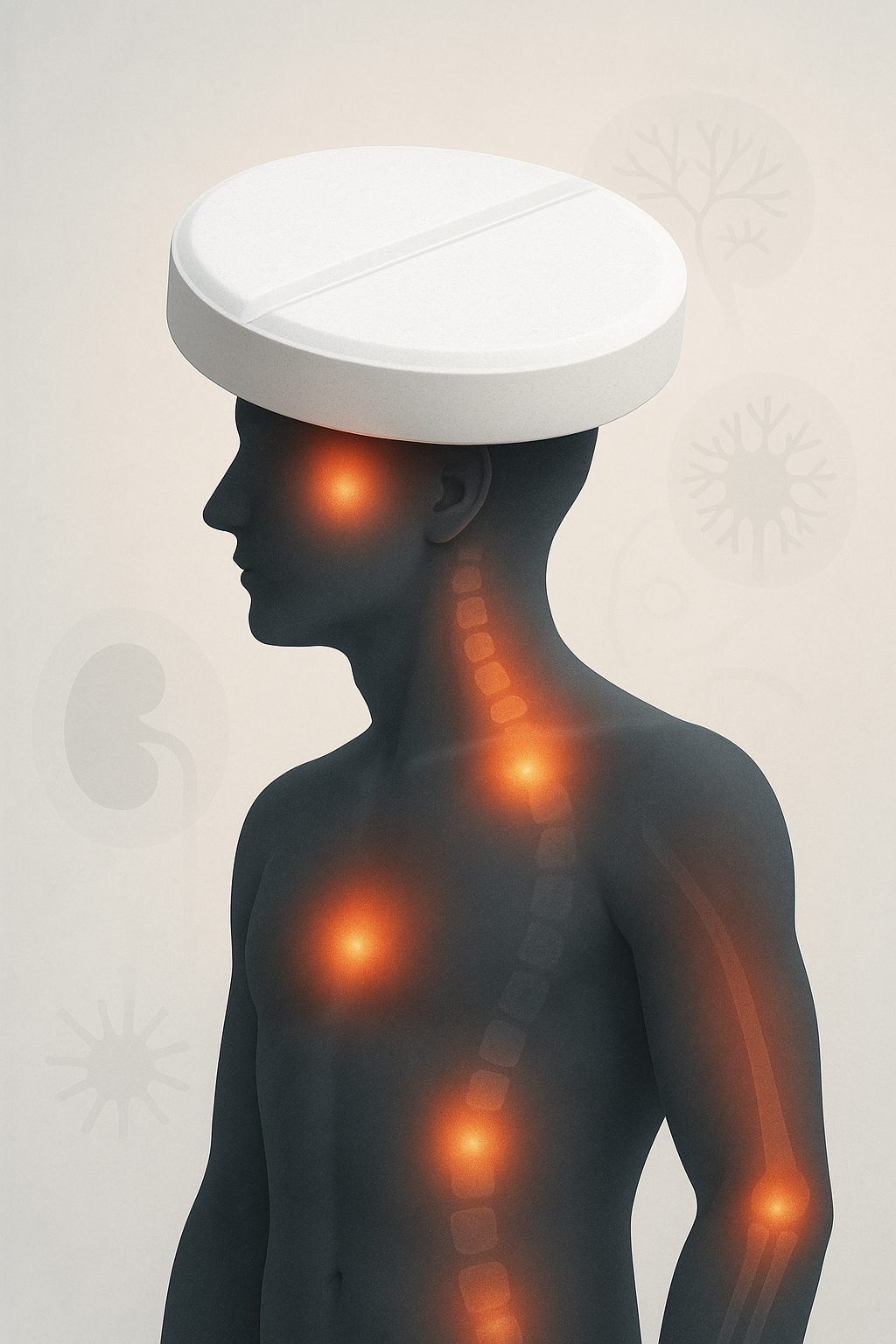
In the modern medical toolkit, painkillers are perhaps the most casually consumed drugs. Over-the-counter or prescription — from paracetamol and ibuprofen to opioids and NSAIDs — they promise instant relief. But behind this short-lived comfort lies a silent sabotage: painkillers are not only masking pain, they are confusing and weakening the body’s most intelligent defense system — the immune system.
What’s in a Painkiller?
Most common painkillers fall into these categories:
– NSAIDs (Nonsteroidal Anti-Inflammatory Drugs): ibuprofen, naproxen
– Paracetamol (Acetaminophen): widely used for headaches, fever, body pain
– Opioids: codeine, tramadol, morphine, used for severe or chronic pain
These drugs work by inhibiting prostaglandins, chemicals that the body produces at injury sites to create inflammation, fever, and pain — essential signals that alert the immune system and activate healing.
How Painkillers Suppress the Immune Dialogue
Pain is not just a symptom. It is a signal — a message from the body that something needs attention. When we blunt that signal with medication, we interrupt a highly coordinated biological conversation.
– NSAIDs not only reduce inflammation but may also suppress neutrophil function, a key player in immune defense.
– Paracetamol has been shown in multiple studies to reduce glutathione levels, a powerful antioxidant used by immune cells to manage oxidative stress.
– Opioids directly suppress immune cell activity and have been linked to increased infections and slower recovery times.
Confused Immunity: A Logical Breakdown
The immune system learns, adapts, and remembers. It is constantly scanning for signals: swelling, heat, pain, fatigue — all of which serve as diagnostic tools.
When painkillers mute these signals, the immune system is left in the dark:
– It senses there’s a problem (inflammation still exists, even if you don’t feel it),
– But it lacks the full range of symptoms to interpret and respond accurately.
– Over time, this can lead to hypersensitivity (as seen in autoimmune conditions) or chronic inflammation that never fully resolves.
In simpler terms: it’s like silencing the fire alarm while the fire is still burning.
Chronic Pain Isn’t Always the Enemy — It’s a Messenger
Persistent pain might be the body’s attempt to draw attention to deeper dysfunction — unresolved infections, inherited immune patterns, emotional trauma, or lifestyle imbalances. The quick fix of a painkiller offers comfort, but it also teaches the body that its cries will be ignored.
The Global Impact of Blind Relief
Long-term use of painkillers has been linked to:
– Kidney and liver damage
– Increased risk of infections
– Worsening of autoimmune conditions
– Development of medication-overuse headaches (a cruel rebound)
The irony is striking: the very drugs we take to avoid discomfort may be prolonging or deepening the root cause of that discomfort.
So What’s the Alternative?
This article isn’t about rejecting all medication — pain relief can be life-saving. But we must begin to respect pain as a teacher, not a nuisance. Integrative approaches, constitutional healing, detoxification, and deep immune rebalancing therapies often provide more lasting outcomes — by working with the body, not against it.
Listening to the Body: Understanding the Signals
Instead of silencing pain, we must decode it.
Persistent or recurring pain is rarely random. It may stem from lifestyle imbalances — poor sleep, dehydration, emotional stress — or point to deeper inherited patterns, like suppressed infections or unresolved miasms. For instance, chronic migraines, arthritis, or fibromyalgia may carry generational imprints. A person suffering today might unknowingly be carrying the burden of illnesses — like tuberculosis, syphilis, or severe fevers — that shaped the immune responses of their ancestors.
In some cases, the signal is deeply physical but tragically misinterpreted. A classmate once suffered unbearable foot pain for over two years. Doctors dismissed it as muscular strain or nerve fatigue — until an MRI revealed a tumor pressing on her spinal vertebrae. The pain wasn’t the problem — it was the body’s desperate warning that something was growing where it shouldn’t. Common Conditions Where Pain Is the Primary Messenger
Understanding the kind of pain can guide people to the root issue:
– Migraines: May indicate neurological inflammation, gut imbalance, liver overload, or inherited diseases displaying different symptoms in later generations
– Joint pain (e.g., knees, fingers): Often linked to autoimmune tendencies like rheumatoid arthritis, or long-term toxin buildup.
– Back pain: Could stem from structural misalignment, kidney strain, or even hidden spinal growths.
– Abdominal pain: May point to gut dysbiosis, parasitic infections, or repressed emotional trauma.
– Foot or leg pain: Could be vascular, neurological, or — as in rare cases — related to deeper spinal pathology.
The key is to ask better questions:
What is my body trying to tell me?
Is this pain chronic or cyclical?
Is there a pattern in my ancestry or environment?
Have I been ignoring this for years?
Toward a Conscious Approach to Healing
Painkillers should not be our default answer. Instead, let’s start **investigating patterns**, studying family histories, checking for epigenetic markers, and looking into holistic methods that support the body’s own healing intelligence.
When we stop fearing pain — and start understanding it — we reclaim the possibility of true healing.

